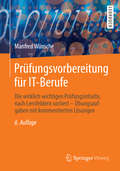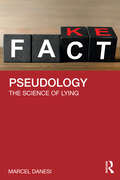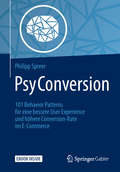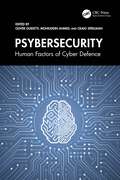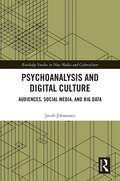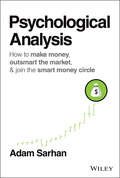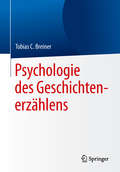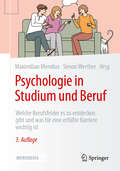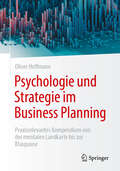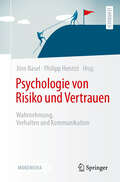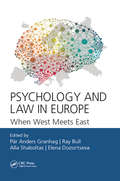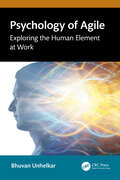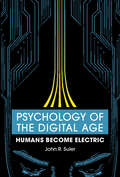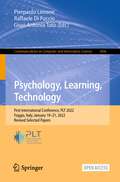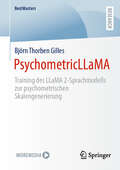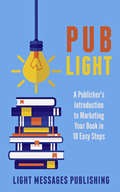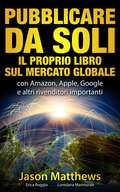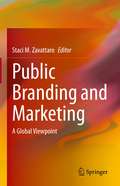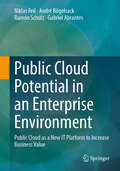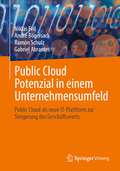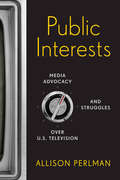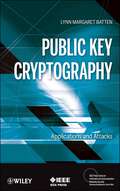- Table View
- List View
Prüfungsvorbereitung für IT-Berufe
by Manfred WünscheDieses Buch ist für angehende Fachinformatiker, IT-System-Elektroniker, IT-Systemkaufleute und Informatikkaufleute geschrieben, die kurz vor der Prüfung stehen. Es bietet eine klare, kompakte Anleitung zur Prüfungsvorbereitung: - Detaillierte Informationen über die Prüfungsanforderungen in IHK-IT-Berufen, für alle vier Berufsbilder, insbesondere auch für Fachinformatiker (beide Richtungen) - Anforderungsgerechte Übungsaufgaben zu den Themen, die für die Prüfung besonders wichtig sind, mit kommentierten Musterlösungen, sowie weitere Recherche-Hinweise zur Vertiefung. - Praxisorientierte Hinweise zur Bewältigung der Klausur-Situation und zur Vorbereitung der mündlichen Prüfung (Projektarbeit, Präsentation, Fachgespräch). Für den Leser gibt es online einen kostenlosen Aktualisierungsservice.
Pseudology: The Science of Lying
by Marcel DanesiIn an age where fake news, conspiracy theories, and outright lies by political and cultural leaders are commonplace, we may be becoming accustomed to lying, or worse, even immune to it. Pseudology unravels the reasons for this by describing a “science of lying” that looks at various aspects of this trait, from how it affects the brain to how it distorts perception.Interest in lying goes back to antiquity and writing and debate has only increased in the present day, but what is missing is a treatment that synthesizes the work from linguists, political scientists, anthropologists, psychologists, neuroscientists, and sociologists, tying them to the philosophical and literary views of lying throughout history. Such a treatment can be called "pseudology": an interdisciplinary science for classifying, collating, and assessing ideas about lying. This book is a comprehensive treatment of pseudology, emphasising the importance of studying lying in our current climate. Pseudology addresses questions such as:• What is a lie?• Why do we lie?• Why are we so susceptible to lying?• How does lying activate false beliefs and generate hatred of others?• How has lying shaped the course of history (at least to some extent)?• How has lying been adopted as a basic thematic element in literature and the arts?Synthesising research from a broad range of disciplines and from the perspective of a leading cognitive linguist, this text weaves ideas and theories about lying cohesively into an overall interdisciplinary science. This landmark book is vital for students and scholars of language as well as anyone interested in politics, sociology, or psychology.
PsyConversion: 101 Behavior Patterns für eine bessere User Experience und höhere Conversion-Rate im E-Commerce
by Philipp SpreerDieses Buch bietet 101 konkret anwendbare Behavior Patterns zur Verbesserung der User Experience und Conversion-Rate entlang der Customer Journey im E-Commerce. Der Autor erläutert, wie unser Gehirn zu Entscheidungen kommt, welche unbewussten Verhaltensmuster dabei verwendet werden und wie diese im Digital-Umfeld aktiviert werden können.Die Wissenschaft ist sich heute einig, dass unser Gehirn mit zwei Systemen arbeitet: einem emotional-intuitiven und einem rationalen Entscheidungssystem. Das rationale System wird im E-Commerce mit ausreichend Argumenten versorgt, es fällt aber nur rund 5% aller Entscheidungen! Die übrigen 95% des Kundengehirns werden bislang sträflich vernachlässigt. Dort werden Entscheidungen auf Basis tief verankerter, unbewusster Verhaltensmuster gefällt – der sogenannten „Behavior Patterns“.Diese Patterns sind so relevant, weil sie bei fast allen Menschen in allen Situationen wirken. Das macht sie für die Anwendung im E-Commerce so attraktiv. Das Wissen um Behavior Patterns ermöglicht es, das Online-Kundenverhalten endlich tiefgreifend zu verstehen und im Sinne einer besseren User Experience und höherer Conversion-Rates gezielt zu beeinflussen.Der Inhalt• Das sind Behavior Patterns und so lassen sie sich im Digital-Umfeld nutzen• So verbessern Sie die User Experience und Ihre Conversion-Rate• Bibliothek von 101 Behavior Patterns von der Awareness- bis zur Retention-Phase• Intuitive Frameworks zur Identifikation passender Behavior Patterns• Ethisch-moralische Grenzen des EinsatzesLeserstimmen„Macht signifikante Performance-Steigerungen möglich.“ Stephan Lein, Director Retail Google„Brilliantes Buch!” Dr. Thilo Pfrang, Founder & Managing Partner von Behavioral Science Consulting„Kommt garantiert auf meinen Schreibtisch!“ Dennis Esterl, Senior Customer Lifecycle Manager bei Amazon„Das perfekte Update für unser Online-Marketing.“ Dr. Matthias Wilken, Leiter Channelmanagement bei Allianz
Psybersecurity: Human Factors of Cyber Defence
by Mohiuddin Ahmed Craig Speelman Oliver GuidettiPsybersecurity: Human Factors of Cyber Defence is a clarion call to action in the face of a stark reality: over 90% of cyberattacks exploit human vulnerabilities, as highlighted by the 2022 Global Risks Report from the World Economic Forum. This gap between the rapid advancement of cyber security technologies and the slower pace of development in human-centric defences poses a formidable challenge to national security and personal safety. Amidst the dazzling progress of AI technologies like ChatGPT and Microsoft Security Co-Pilot, the human element of cyber security remains critically underdeveloped.Set against the backdrop of the Australian government's ambitious goal to become the world's most cybersecure nation by 2030, this book embarks on a mission to address the overlooked human factors in cyber defence. It advocates for a balanced approach that not only relies on technological advancements but also significantly enhances the human aspects of cyber security.Through an interdisciplinary exploration, Psybersecurity delves into how cyberthreats exploit human vulnerabilities and offers innovative solutions for building resilience against these vulnerabilities. It examines the necessity for cyber security strategies that encompass psychological insights, systemic resilience, and the mitigation of human errors, particularly within critical infrastructures and cyber-physical systems (CPS).Furthermore, this work critiques existing cyber security education frameworks, proposing a comprehensive curriculum that equips individuals with technical skills and the behavioural competencies needed to navigate the cyber landscape ethically and effectively. It also addresses AI's ethical dilemmas and psychological impacts, offering a forward-looking perspective on combating AI-driven harassment and endorsing a new field of study: "Psybersecurity."Psybersecurity: Human Factors of Cyber Defence aims to bridge the gap between cyber security and human sciences, ignite a transformation in understanding, and fortify our digital world. It is an essential read for academics, professionals, and anyone committed to building a safer, more resilient cyber future in alignment with Australia's 2030 vision.
Psychoanalysis and Digital Culture: Audiences, Social Media, and Big Data (Routledge Studies in New Media and Cyberculture)
by Jacob JohanssenPsychoanalysis and Digital Culture offers a comprehensive account of our contemporary media environment—digital culture and audiences in particular—by drawing on psychoanalysis and media studies frameworks. It provides an introduction to the psychoanalytic affect theories of Sigmund Freud and Didier Anzieu and applies them theoretically and methodologically in a number of case studies. Johanssen argues that digital media fundamentally shape our subjectivities on affective and unconscious levels, and he critically analyses phenomena such as television viewing, Twitter use, affective labour on social media, and data-mining. How does watching television involve the body? Why are we so drawn to reality television? Why do we share certain things on social media and not others? How are bodies represented on social media? How do big data and data mining influence our identities? Can algorithms help us make better decisions? These questions amongst others are addressed in the chapters of this wide-ranging book. Johanssen shows in a number of case studies how a psychoanalytic angle can bring new insights to audience studies and digital media research more generally. From audience research with viewers of the reality television show Embarrassing Bodies and how they unconsciously used it to work through feelings about their own bodies, to a critical engagement with Hardt and Negri's notion of affective labour and how individuals with bodily differences used social media for their own affective-digital labour, the book suggests that an understanding of affect based on Freud and Anzieu is helpful when thinking about media use. The monograph also discusses the perverse implications of algorithms, big data and data mining for subjectivities. In drawing on empirical data and examples throughout, Johanssen presents a compelling analysis of our contemporary media environment.
Psychological Analysis: How to Make Money, Outsmart the Market, and Join the Smart Money Circle (Wiley Trading)
by Adam SarhanBeat the market by using Psychological Analysis for investing and trading under any conditions Conventional wisdom tells us that people are rational and make rational decisions with their money. But that’s simply not true considering most people fail to beat the market. Conventional wisdom also tells us that there are two primary ways to approach the market: technical and fundamental analysis. Again, that is not true because if it were—everyone would be rich. Think about it, how many times have you seen stocks with poor fundamentals go up, or stocks with great technicals go down? It’s obvious that something is missing. Author Adam Sarhan, Founder and CEO of 50 Park Investments, developed a new approach, titled, Psychological Analysis (PA). Coined by the author, the term teaches you how to make rational, not emotional, decisions with your money and shows you how to analyze both the individual and collective market mindset at a particular time based on the behavior and decision-making of people in the real-world. Psychological Analysis is designed to tip the odds of success in your favor. After studying every major economic and market cycle going back to the 3rd century, the author explains that human nature is the one constant and tells you what actually drives markets. Psychological Analysis is responsible for major and minor market moves today, tomorrow, and all throughout history. Adam shows you that there are more factors that influence price than just fundamental or technical analysis and how to bring out the smart money superhero inside you. This invaluable guide helps you: Make rational, not emotional, decisions with your money—especially when you are under pressure Understand the psyche of the market so you can learn how to join the Smart Money Circle and consistently take money out Generate above average returns in all market environments Incorporate Psychological Analysis into your overall trading and investing strategy so you can make smarter decisions on and off Wall Street Psychological Analysis: How to Outsmart the Market One Trade at a Time is a must-have resource for traders, investors, finance professionals, and anyone who wants to profit regardless of market conditions.
Psychological Insights on the Role and Impact of the Media During the Pandemic: Lessons from COVID-19
by Barrie GunterThis volume places the spotlight on the role different media and communications systems played in informing the public about the pandemic, shaping their views about what was happening and contributing to behavioural compliances with pandemic-related restrictions. Throughout the pandemic, media coverage has played an important role in drawing attention to specific messages, influencing public risk perceptions and fear responses. Mainstream media and other electronic communication systems such as Facebook and WhatsApp have been pivotal in getting pandemic information out to the public, thereby influencing their beliefs, attitudes and behaviour and engaging them generally in the pandemic as stakeholders. In this timely volume, author Barrie Gunter considers how people reacted to this coverage and its contribution to their understanding of what was going on, including the influence of fake news and misinformation on public beliefs about the pandemic, from anti-lockdown protests to the "anti-vaxx" movement. In addition, looking at how government messaging was not always consistent or clear and how different authorities were found not always to be in harmony or compliance with the messages they put out, Gunter examines the harm done by presenting different publics with ambiguous or conflicting narratives. Drawing out important communications strategy lessons to be learned for the future, this is essential reading for students and researchers in psychology, public health and medical sciences and for policymakers who assess government strategies, responses and performance.
Psychologie des Geschichtenerzählens
by Tobias C. BreinerIn diesem Buch geht es um die Psychologie guter Geschichten und deren Handlungsfiguren. Es beantwortet Fragen wie:Warum rühren uns manche Filme zu Tränen und andere lassen uns kalt?Warum fesseln uns manche Romane so, dass wir bis tief in die Nacht weiterlesen? Warum quälen wir uns dagegen durch manche Pflichtlektüre hindurch?Warum zocken wir manches Adventure-Game bis zum letzten Level während wir bei anderen schnell die Lust verlieren? Das Werk ist für all diejenigen verfasst, die sich in irgendeiner Weise mit der Erzeugung und Bewertung von Handlungen befassen. Sowohl Charakter- und Game-Designer profitieren durch neue archetypische Modelle und Psychologen können mit der hier präsentierten dodekazyklischen Heldenreise innovative therapeutische Methoden entwickeln. Roman- und Drehbuchautoren bekommen eine Blaupause für erfolgsversprechende Geschichten, die sich auch auf das Interactive Storytelling übertragen lässt und Regisseure sowie Film-, Computerspiel- und Literaturkritiker erhalten durch den Inhalt des Werkes gezielte Bewertungskriterien.
Psychologie in Studium und Beruf: Welche Berufsfelder es zu entdecken gibt und was für eine erfüllte Karriere wichtig ist
by Simon Werther Maximilian MendiusDieses Buch nimmt Sie mit auf eine faszinierende Reise durch die vielfältigen Tätigkeitsfelder von Psycholog:innen. Dabei lernen Sie neben den etablierten Anwendungsgebieten wie klinische Psychologie und Wirtschaftspsychologie auch vermeintlich exotische Arbeitsfelder wie Polizei- oder Verkehrspsychologie oder Data Science kennen. Finden Sie für sich heraus, ob und für welche Tätigkeit in der Psychologie Ihr Herz schlägt und wie Sie diesen Wunsch verwirklichen können. Alle Kapitel sind von erfahrenen Expert:innen aus der Praxis verfasst. Sie vermitteln Ihnen einen sowohl authentischen als auch realistischen Einblick in den jeweiligen Berufsalltag und räumen auf mit gängigen Vorurteilen. Darüber hinaus eröffnen eingeflochtene Interviews mit praktisch tätigen Psycholog:innen und Expert:innen aus der Wissenschaft bereichernde Perspektiven. In dieser Neuauflage von Faszination Psychologie – Berufsfelder und Karrierewege haben wir zudem exklusive Webinhalte ergänzt, wo Sie in spannenden Formaten weitere relevante Einblicke gewinnen können.
Psychologie und Strategie im Business Planning: Praxisrelevantes Kompendium von der mentalen Landkarte bis zur Blaupause
by Oliver HoffmannEin Business Plan ist weit mehr als nur ein strukturiertes Dokument: Er ist ein mentales Werkzeug, das die Denkweise, Risikobereitschaft und strategische Anpassungsfähigkeit eines Unternehmers reflektiert. Denn erfolgreiches Business Planning erfordert nicht nur eine fundierte Marktanalyse und präzise Finanzplanung, sondern auch ein Verständnis der psychologischen Mechanismen, die unternehmerische Entscheidungen beeinflussen. Business Planning ist nicht nur Strategie, sondern Psychologie. Kognitive Verzerrungen, emotionale Entscheidungsprozesse und unbewusste Annahmen prägen maßgeblich, wie realistisch und umsetzbar ein Plan ist. Ein Business Plan ist eine mentale Landkarte: Er dient nicht nur als wirtschaftliche Prognose, sondern als Orientierungshilfe in einem unsicheren Umfeld. Rationalität vs. Emotionen im Business Planning: Systematische Denkfehler wie Optimismus-Bias oder Verlustaversion beeinflussen, wie Risiken und Chancen eingeschätzt werden. Flexibilität und psychologische Widerstandskraft sind entscheidend: Ein starrer Plan ist wertlos, wenn er nicht die Fähigkeit zur Anpassung in dynamischen Märkten mit einbezieht. Investoren und Partner investieren in Menschen, nicht nur in Zahlen: Eine überzeugende Vision, ein reflektiertes Risikomanagement und ein realistisches Geschäftsmodell sind ausschlaggebend für Vertrauen und Erfolg. Das Buch zeigt, wie Business Planning methodisch funktioniert und wie es bewusst psychologisch optimiert werden kann, um Denkfallen zu vermeiden, bessere Entscheidungen zu treffen und langfristig unternehmerischen Erfolg zu ermöglichen. Die Zielgruppen • Existenzgründer und Start-up-Unternehmer • Unternehmer • Investoren und Business Angels • Manager und Führungskräfte <p s
Psychologie von Risiko und Vertrauen: Wahrnehmung, Verhalten und Kommunikation
by Philipp Henrizi Jörn BaselPsychologie von Risiko und Vertrauen Unsicherheit und Unplanbarkeit nehmen zu, globale Krisen, Fake News und Skepsis erodieren bestehendes Vertrauen. Zusätzlich wird diese Dynamik durch technologische Entwicklungen befeuert, deren Akzeptanz maßgeblich von einer subjektiven Bewertung der Chancen und Risiken abhängt. Risikokompetenz, Risikomündigkeit oder auch Vertrauensaufbau sind hierbei zentrale Schlagwörter, welche exemplarisch für einen fundierten Umgang mit Risiko und Vertrauen stehen. Dieses Buch bietet Ihnen in 11 Kapiteln eine praxisorientierte Einführung in die Psychologie von Risiko und Vertrauen. Sie vertiefen Ihre Kenntnisse über Risikokommunikation im Krisenfall, den Umgang mit Misstrauen und auch wie es gelingt Vertrauen als entscheidendes Bindeglied zu etablieren, um Innovation und Fortschritt zu ermöglichen.Die didaktisch eingängig strukturierten Inhalte mit Lernzielen und Kontrollfragen stützen sich auf bewährte psychologische und aktuelle wissenschaftliche Erkenntnisse. Vielfältige Praxisbeispiele, wie z.B. von einer Extremsportlerin, einem Flight Safety Officer und einem katholischen Missbrauchsaufklärer, vermitteln einen persönlichen Bezug und zeigen Ihnen, wie vielschichtig sich der Umgang mit Risiko und Vertrauen gestalten kann. Dazu erhalten Sie hilfreiche Zusatzmaterialien über die Begleitwebseite. Kapitel 4 ist unter einer Creative Commons Attribution 4.0 International License über link.springer.com frei verfügbar (Open Access).Zielgruppen Studierende der Wirtschaftspsychologie und anderer Studiengänge im Bereich Wirtschaft, Entscheidungsträger, Führungskräfte und alle, die sich für den Umgang mit Risiko und Vertrauen interessieren.Zu den Herausgebern Prof. Dr. Jörn Basel – Professor für Wirtschaftspsychologie an der Hochschule Luzern (HSLU). Mitglied des First International Network on Trust (FINT). Seine Forschung beschäftigt sich unter anderem damit, wie Organisationen verlorenes Vertrauen wiederaufbauen können. Prof. Dr. Philipp Henrizi – Professor und Programmleiter Governance, Risk and Compliance der Hochschule Luzern (HSLU). Diverse Forschungsprojekte und Publikationen im Bereich Risk Management und Compliance Management. Mitglied im European Risk Research Network (ERRN).
Psychology and Law in Europe: When West Meets East
by Pär Anders Granhag, Ray Bull, Alla Shaboltas and Elena DozortsevaOffering carefully curated articles from the European Association of Psychology and Law (EAPL), this book features chapters from a truly international group of scholars. This text is the first of its kind to offer insights into current developments in psychology and law in Russia. The field of psychology and law has a very long and strong tradition in Russia, but very little is known, as Russian scholars rarely publish their works in English. The volume also contains state-of-the-art chapters on topics at the very core of psychology and law, including offender profiling, lie detection, crime linking, false memories, and witness interviewing. Features Provides rare insight into Russian history of forensic and criminal psychology Covers core topics in the discipline Offers international scope from a diverse array of contributors Psychology and Law in Europe: When West Meets East is a text of interest for students of psychology, law, or criminal justice, as well as scholars and practitioners in the field. This text offers a window into global advances in psychology and law.
Psychology of Agile: Exploring the Human Element at Work
by Bhuvan UnhelkarAgile is a mindset and a culture that has evolved beyond software development to encompass all forms of project management, business organizations, defense, and society. In today’s fast- paced and ever- changing world, adopting an Agile approach is essential for organizations to thrive and maintain competitiveness. This book aims to extend the concept of Agility beyond the four declarations of the Manifesto and apply it to various projects, organizations, and even society. The book delves into the intricacies of Agile and highlights its significance in modern workplaces. It emphasizes that Agile is more than just a set of tools and techniques; it is a way of thinking and a culture that requires a deep understanding of psychology and sociology. Key topics discussed: Agility as a leadership characteristic and the meta- mind of Agile • Agile mind- map beyond the manifesto and methods Psychological frameworks (Maslow, TA, MBTI, Left- Right, Slow- Fast) relevant to Agile work and psychosocial games at work Psychological development and Composite Agile Method and Strategy (CAMS) Agile organizational structures and behaviors Agile Transformations in the Digital Age This book is valuable for Agile coaches, mentors, and Scrum Masters looking for more comprehensive answers than what an Agile framework can provide. It is also helpful for business leaders, stakeholders, and product owners who need to deal with ambiguous or unclear issues, as well as project managers and team leaders who already have experience in Agile but feel like something is missing. Additionally, HR professionals and trainers involved in Agile transformation can benefit from this book.
Psychology of Entertainment: The Psychology Of Its Appeal (Routledge Communication Series)
by Jennings Bryant Peter VordererAs entertainment becomes a trillion-dollar-a-year industry worldwide, as our modern era increasingly lives up to its label of the "entertainment age," and as economists begin to recognize that entertainment has become the driving force of the new world economy, it is safe to say that scholars are beginning to take entertainment seriously. The scholarly spin on entertainment has been manifested in traditional ways, as well as innovative ones. Representing the current state of theory and research, Psychology of Entertainment promises to be the most comprehensive and up-to-date volume on entertainment. It serves to define the new area of study and provides a theoretical spin for future work in the area.Divided into three basic parts, this book:*addresses the fundamental mechanisms and processes involved in orienting to and selecting entertainment fare, as well as receiving and processing it;*explores the mechanisms and processes by which we are entertained by the media messages we select and receive; and*provides an opportunity for the application of well-established as well as emerging psychological and psychobiological theories to be applied to the study of entertainment in ways that seldom have been utilized previously.Psychology of Entertainment will appeal to scholars, researchers, and graduate students in media studies and mass communication, psychology, marketing, and other areas contributing to the entertainment studies area.
Psychology of the Digital Age
by John SulerBased on two decades of participant-observation field research in diverse online environments, this engaging book offers insights for improving lifestyles and enhancing wellbeing in the digital age. John R. Suler, a founder of the field of cyberpsychology, explains its fundamental principles across a wide variety of topics, including online identity management, disinhibition, communication via text and photographs, intimacy and misunderstandings in online relationships, conflicting attitudes toward social media, addiction, deviant behavior, virtual reality, artificial intelligence, and media overload. He provides a new framework, the 'Eight Dimensions of Cyberpsychology Architecture', which researchers, students, and general readers interested in cyberpsychology can apply as a valuable tool for creating and understanding different digital realms. Psychology of the Digital Age focuses on the individual, shedding new light on our conscious as well as subconscious reactions to online experiences and our intrinsic human need to self-actualize.
Psychology, Learning, Technology: First International Conference, PLT 2022, Foggia, Italy, January 19–21, 2022, Revised Selected Papers (Communications in Computer and Information Science #1606)
by Pierpaolo Limone Raffaele Di Fuccio Giusi Antonia TotoThis open access book constitutes the refereed proceedings of 1st International Workshop on Psychology, Learning, Technology, PLT 2022, Foggia, Italy, during January 2022. The 8 full papers presented here were carefully reviewed and selected from 23 submissions. In addition, one invited paper is also included. Psychology, Learning, ad Technology Conference (PLT2022) aims to explore learning paths that incorporate digital technologies in innovative and transformative ways and the improvement of the psychological and relational life. The conference includes topics about the methodology of application of the ICT tools in psychology and education: from blended learning to the application of artificial intelligence in education; from the teaching, learning, and assessment strategies and practices to the new frontiers on Human-Computer Interaction.
Psychology, Learning, Technology: Second International Conference, PLT 2022, Foggia, Italy, November 17–18, 2022, Revised Selected Papers (Communications in Computer and Information Science #2089)
by Raffaele Di Fuccio Giusi Antonia TotoThis book constitutes the refereed proceedings of Second International Workshop on Psychology, Learning, Technology, PLT 2022, which took place in Foggia, Italy, in November 2022. The 14 full papers were carefully reviewed and selected from 42 submissions. The papers were organized in topical sections as follows: Digital psychology and digital setting; advances in technology enhanced learning and teaching; and bilingualism and second language learning.
PsychometricLLaMA: Training des LLaMA 2-Sprachmodells zur psychometrischen Skalengenerierung (BestMasters)
by Björn Thorben GillesDie rasante Entwicklung generativer Sprachmodelle eröffnet neue Möglichkeiten der psychologischen Skalenentwicklung. Diese prä-registrierte Arbeit untersucht den Einsatz von Sprachmodellen zur automatischen Generierung von Likert-Items, aufbauend auf bisherigen Ansätzen. Ein neuer Datensatz wurde durch eine systematische Literaturrecherche erstellt und mit bestehenden Quellen kombiniert, um das LLaMA 2-Sprachmodell mittels Low-Rank Adaption zu trainieren. Das Modell generiert auf Basis einer Definition psychologische Items mit Anpassungsmöglichkeiten für Schwierigkeit und Kreativität. Zur Überprüfung der psychometrischen Güte wurden Items zu sechs Konstrukten generiert und online mit N = 200 Personen erhoben. Die Ergebnisse zeigten vielversprechende psychometrische Kennwerte: Die meisten Items konnten eine gute interne Konsistenz und hohe Korrelationen mit den Originalskalen aufweisen. Allerdings war die Anpassung der Item-Schwierigkeit nicht erfolgreich. Unterschiede in Antwortverteilung und Interkorrelationen zwischen KI- und Originalskalen wurden festgestellt. Insgesamt leistet diese Arbeit einen bedeutenden Beitrag zur psychologischen Fragebogenkonstruktion durch das Fine-Tuning eines KI-Modells zur Generierung reliabler und valider Items.
Pub Light: A Publisher's Introduction to Selling Your Book in 10 Easy Steps
by Elizabeth Turnbull Kaitlin AlbersPub Light provides a concise, comprehensive guide to assist authors in the daunting task of properly marketing their books. We've compiled the best tips and tricks in the industry from marketing experts, independent authors, and professional bloggers. In 10 easy steps, we reveal the best ways to leverage your audience, from utilizing social media, networking with people you know, getting your book reviewed, and more!
Pubblicare da soli il proprio libro sul mercato globale
by Jason Matthews Erica Roggio e Loredana MarmoraleHai scritto un libro? Vuoi vendere su Amazon, Apple, Google e altri importanti rivenditori? Risparmia tempo e denaro vendendo e-book online con questa semplice guida all'auto-pubblicazione. Risolvi i tuoi dubbi su come preparare il tuo libro per caricarlo sulle piattaforme dei principali rivenditori. Il manuale, che include consigli per far emergere il tuo libro rispetto a tanti altri, è stato scritto da Jason Matthews, esperto di auto-pubblicazione e autore di numerose opere letterarie di narrativa e saggistica. I suoi libri sono stati tradotti in 8 lingue e i suoi corsi video sono stati seguiti da studenti di oltre 123 paesi. Preparati a raggiungere velocemente gli obiettivi di pubblicazione. Imparerai a: •formattare il tuo libro per i principali rivenditori •convertirlo in ePub in modo che sia visualizzato correttamente su tablet, smartphone e Kindle •disegnare una copertina accattivante •vendere attraverso Amazon, Apple, Google Play, Barnes & Noble, Smashwords, Kobo e altre piattaforme •utilizzare i social media in maniera intelligente (Facebook, Twitter, Google Plus, YouTube) •bloggare e creare la tua piattaforma autore •ottenere recensioni, e tanto altro ancora. Trova soluzioni per le tue esigenze di modifica, copyright, ISBN e altri requisiti, oltre alle migliori opzioni e strategie per lavorare con i professionisti. I lettori di tutto il mondo sono affamati di nuovi libri. Sei pronto a condividere il tuo? Inizia oggi!
Public Branding and Marketing: A Global Viewpoint
by Staci M. ZavattaroThis edited volume details public branding and marketing from a global, comparative perspective. Place branding and marketing practices are now prominent in cities, states, nations, regions, and organizations all over the world. While disciplines such as hospitality management, tourism marketing, and business marketing have made inroads into understanding the intricacies of place branding, research in public administration and policy is still emerging. This volume fills that research gap. Including accounts from both the academic and practitioner communities, this book bridges the academic-practitioner divide and provides a holistic account of branding and marketing in public organizations as well as immediate application and lessons learned. The book takes an explicit public administration approach, focusing on a wide range of topics such as branding leadership, co-creation, stakeholder engagement, education, non-profit marketing and branding, and city administration. The book is divided into four sections. Section I highlights the process of developing and communicating public branding and marketing efforts. Section II focuses specifically on how social media and other digital technologies are used to communicate and evaluate place branding strategies. Section III centers on branding at the local government level. Section IV highlights how various stakeholder groups come together (or not) when participating in strategic branding efforts. Presenting various methodologies, approaches, and implications of place branding and marketing across differing social, cultural, political, and economic conditions, this book will be of use to scholars and students in public. administration, tourism studies, and business administration as well as professionals and practitioners in the public branding and marketing field.
Public Cloud Potential in an Enterprise Environment: Public Cloud as a New IT Platform to Increase Business Value
by André Bögelsack Niklas Feil Ramón Schulz Gabriel AbrantesThe transformation to the public cloud comes with many challenges. The book explains three phases that form the basis for determining a company's position in the transformation. Each stage outlines a maturity level of transformation. An assessment framework guides the reader through the analysis of cloud readiness to identify the current stage of the organization and to reach the next stage of realizing the value of the cloud. The framework is supplemented by practical examples.
Public Cloud Potenzial in einem Unternehmensumfeld: Public Cloud als neue IT-Plattform zur Steigerung des Geschäftswerts
by André Bögelsack Niklas Feil Ramón Schulz Gabriel AbrantesDie Transformation in die Public Cloud ist mit vielen Herausforderungen verbunden. Das Buch erläutert drei Phasen, die die Grundlage für die Ermittlung der Position eines Unternehmens in der Transformation bilden. Jede Stufe umreißt einen Reifegrad der Transformation. Ein Bewertungsrahmen führt den Leser durch die Analyse der Cloud-Readiness zur Identifikation der derzeitigen Stufe des Unternehmens und um die nächste Stufe zur Ausschöpfung des Mehrwerts der Cloud zu erreichen. Das Framework wird durch praxisnahe Beispiele ergänzt.Der Inhalt: Kombination eines mehrstufigen, ganzheitlichen FrameworksBewertung zur Ermittlung des Ausgangspunkts der Cloud-ReadinessÜberblick über die Reifegrade der Transformation mit PraxisbeispielenDie ZielgruppenIT-Entscheidungsträger von Unternehmen aus allen Branchen
Public Interests: Media Advocacy and Struggles over U.S. Television
by Allison PerlmanNearly as soon as television began to enter American homes in the late 1940s, social activists recognized that it was a powerful tool for shaping the nation's views. By targeting broadcast regulations and laws, both liberal and conservative activist groups have sought to influence what America sees on the small screen. Public Interests describes the impressive battles that these media activists fought and charts how they tried to change the face of American television. Allison Perlman looks behind the scenes to track the strategies employed by several key groups of media reformers, from civil rights organizations like the NAACP to conservative groups like the Parents Television Council. While some of these campaigns were designed to improve the representation of certain marginalized groups in television programming, as Perlman reveals, they all strove for more systemic reforms, from early efforts to create educational channels to more recent attempts to preserve a space for Spanish-language broadcasting. Public Interests fills in a key piece of the history of American social reform movements, revealing pressure groups' deep investments in influencing both television programming and broadcasting policy. Vividly illustrating the resilience, flexibility, and diversity of media activist campaigns from the 1950s onward, the book offers valuable lessons that can be applied to current battles over the airwaves.
Public Key Cryptography
by Lynn Margaret BattenComplete coverage of the current major public key cryptosystems their underlying mathematics and the most common techniques used in attacking them Public Key Cryptography: Applications and Attacks introduces and explains the fundamentals of public key cryptography and explores its application in all major public key cryptosystems in current use, including ElGamal, RSA, Elliptic Curve, and digital signature schemes. <P><P>It provides the underlying mathematics needed to build and study these schemes as needed, and examines attacks on said schemes via the mathematical problems on which they are based - such as the discrete logarithm problem and the difficulty of factoring integers. The book contains approximately ten examples with detailed solutions, while each chapter includes forty to fifty problems with full solutions for odd-numbered problems provided in the Appendix. Public Key Cryptography: * Explains fundamentals of public key cryptography * Offers numerous examples and exercises * Provides excellent study tools for those preparing to take the Certified Information Systems Security Professional (CISSP) exam * Provides solutions to the end-of-chapter problems Public Key Cryptography provides a solid background for anyone who is employed by or seeking employment with a government organization, cloud service provider, or any large enterprise that uses public key systems to secure data.
